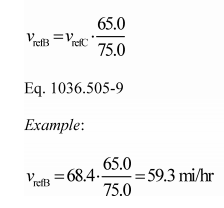['Air Programs']
['Air Emissions']
02/20/2023
...
(a) Starting in model year 2021, you must measure CO2 emissions using the SET duty cycle in 40 CFR 86.1362 as described in §1036.501, or using the SET duty cycle in this section.
(b) Perform SET testing with one of the following procedures:
(1) For engine testing, the SET duty cycle is based on normalized speed and torque values relative to certain maximum values. Denormalize torque as described in 40 CFR 1065.610(d). Denormalize speed as described in 40 CFR 1065.512.
(2) For hybrid powertrain and hybrid engine testing, follow 40 CFR 1037.550 to carry out the test, but do not compensate the duty cycle for the distance driven as described in 40 CFR 1037.550(g)(4), for hybrid engines select the transmission from Table 1 of §1036.540 substituting “engine” for “vehicle” and “highway cruise cycle” for “SET”, and cycles do not follow 40 CFR 1037.550(j). For cycles that begin with a set of contiguous idle points, leave the transmission in neutral or park for the full initial idle segment. Place the transmission into drive within 5 seconds of the first nonzero vehicle speed setpoint. Place the transmission into park or neutral when the cycle reaches SET mode 14. Use the following vehicle parameters in place of those in 40 CFR 1037.550 to define the vehicle model in 40 CFR 1037.550(a)(3):
(i) Determine the vehicle test mass, M, as follows:

Where:
P contrated = the continuous rated power of the hybrid system determined in §1036.527.
P contrated = 350.1 kW
M = 15.1·350.11.31 = 32499 kg
(ii) Determine the vehicle frontal area, A front, as follows:
(A) For M ? 18050 kg:

Example:
M = 16499 kg
A front = ?169 · 10?8 · 164992 6.33 · 10?4 · 16499 1.67 = 7.51 m2
(B) For M > 18050 kg, A front = 7.59 m2.
(iii) Determine the vehicle drag area, C d A, as follows:

Where:
g = gravitational constant = 9.80665 m/s2.
? = air density at reference conditions. Use ? = 1.1845 kg/m3.

(iv) Determine the coefficient of rolling resistance, C rr, as follows:

(vii) Select a drive axle ratio, k a, that represents the worst-case pair of drive axle ratio and tire size for CO2 expected for vehicles in which the powertrain will be installed. This is typically the highest numeric axle ratio.
(viii) Select a tire radius, r, that represents the worst-case pair of tire size and drive axle ratio for CO2 expected for vehicles in which the powertrain will be installed. This is typically the smallest tire radius.
(ix) If you are certifying a hybrid powertrain system without the transmission, use a default transmission efficiency of 0.95. If you certify with this configuration, you must use 40 CFR 1037.550(a)(3)(ii) to create the vehicle model along with its default transmission shift strategy. Use the transmission parameters defined in Table 1 of §1036.540 to determine transmission type and gear ratio. For Light and Medium HDVs, use the Light and Medium HDV parameters for the FTP and SET. For Tractors and Heavy HDVs, use the Tractor and Heavy HDV transient cycle parameters for the FTP and the Tractor and Heavy HDV highway cruise cycle parameters for the SET.
(x) Select axle efficiency, Eff axle, according to 40 CFR 1037.550.
(c) Measure emissions using the SET duty cycle shown in Table 1 of this section to determine whether engines and hybrid powertrains meet the steady-state compression-ignition standards specified in subpart B of this part. Table 1 of this section specifies settings for engine and hybrid powertrain testing, as follows:
(1) The duty cycle for testing engines involves a schedule of normalized engine speed and torque values.
(2) The duty cycle for hybrid powertrain testing involves a schedule of vehicle speeds and road grade.
(i) Determine road grade at each point based on the continuous rated power of the hybrid powertrain system, P contrated, in kW determined in §1036.527, the vehicle speed (A, B, or C) in mi/hr for a given SET mode, v ref[speed], and the specified road grade coefficients using the following equation:

Example for SET mode 3a in Table 1 to this section:
P contrated = 345.2 kW
v refB = 59.3 mi/hr
Road grade = 8.296 · 10?9 · 345.23 (?4.752 · 10?7) · 345.22 · 59.3 1.291 · 10?5 · 345.22 2.88 · 10?4 · 59.32 · 4.524 · 10?4 · 345.2 · 59.3 (?1.802 · 10?2) · 345.2 (?1.83 · 10?1) · 59.3 8.81 = 0.53%
(ii) Use the vehicle C speed determined in §1036.527 and determine the vehicle A and B speeds as follows:
(A) Determine vehicle A speed using the following equation:



[86 FR 34381, Jun. 29, 2021]
['Air Programs']
['Air Emissions']
UPGRADE TO CONTINUE READING
Load More
J. J. Keller is the trusted source for DOT / Transportation, OSHA / Workplace Safety, Human Resources, Construction Safety and Hazmat / Hazardous Materials regulation compliance products and services. J. J. Keller helps you increase safety awareness, reduce risk, follow best practices, improve safety training, and stay current with changing regulations.
Copyright 2025 J. J. Keller & Associate, Inc. For re-use options please contact copyright@jjkeller.com or call 800-558-5011.
